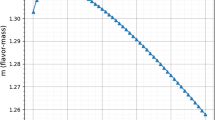Abstract
We consider a holographic description of a system of strongly coupled fermions in 2 + 1 dimensions based on a D7-brane probe in the background of D3-branes, and construct stable embeddings by turning on worldvolume fluxes. We study the system at finite temperature and charge density, and in the presence of a background magnetic field. We show that Minkowski-like embeddings that terminate above the horizon describe a family of quantum Hall states with filling fractions that are parameterized by a single discrete parameter. The quantization of the Hall conductivity is a direct consequence of the topological quantization of the fluxes. When the magnetic field is varied relative to the charge density away from these discrete filling fractions, the embeddings deform continuously into black-hole-like embeddings that enter the horizon and that describe metallic states. We also study the thermodynamics of this system and show that there is a first order phase transition at a critical temperature from the quantum Hall state to the metallic state.
Similar content being viewed by others
References
R.B. Laughlin, Anomalous quantum Hall effect: An incompressible quantum fluid with fractionally charged excitations, Phys. Rev. Lett. 50 (1983) 1395 [SPIRES].
V.J. Goldman and B. Su, Resonant Tunneling in the Quantum Hall Regime: Measurement of Fractional Charge, Science 267 (1995) 1010.
R. dePicciotto, M. Reznikov, M. Heiblum, V. Umansky, G. Bunin and D. Mahalu, Direct observation of a fractional charge, Nature 389 (1997) 162.
T. Sakai and S. Sugimoto, Low energy hadron physics in holographic QCD, Prog. Theor. Phys. 113 (2005) 843 [hep-th/0412141] [SPIRES].
T. Sakai and S. Sugimoto, More on a holographic dual of QCD, Prog. Theor. Phys. 114 (2005) 1083 [hep-th/0507073] [SPIRES].
S.J. Rey, Quantum phase transition from string theory, talk at Strings 2007, Madrid Spain, 25 – 29 June 2007.
S.-J. Rey, String theory on thin semiconductors: Holographic realization of Fermi points and surfaces, Prog. Theor. Phys. Suppl. 177 (2009) 128 [arXiv:0911.5295] [SPIRES].
J.L. Davis, P. Kraus and A. Shah, Gravity Dual of a Quantum Hall Plateau Transition, JHEP 11 (2008) 020 [arXiv:0809.1876] [SPIRES].
J. Alanen, E. Keski-Vakkuri, P. Kraus and V. Suur-Uski, AC Transport at Holographic Quantum Hall Transitions, JHEP 11 (2009) 014 [arXiv:0905.4538] [SPIRES].
D.K. Hong and H.-U. Yee, Holographic aspects of three dimensional QCD from string theory, JHEP 05 (2010) 036 [arXiv:1003.1306] [SPIRES].
R.C. Myers and M.C. Wapler, Transport Properties of Holographic Defects, JHEP 12 (2008) 115 [arXiv:0811.0480] [SPIRES].
D.J. Thouless, Topological interpretations of quantum Hall conductance, J. Math. Phys. 35 (1994) 5362.
E. Keski-Vakkuri and P. Kraus, Quantum Hall Effect in AdS/CFT, JHEP 09 (2008) 130 [arXiv:0805.4643] [SPIRES].
M. Fujita, W. Li, S. Ryu and T. Takayanagi, Fractional Quantum Hall Effect via Holography: Chern-Simons, Edge States and Hierarchy, JHEP 06 (2009) 066 [arXiv:0901.0924] [SPIRES].
Y. Hikida, W. Li and T. Takayanagi, ABJM with Flavors and FQHE, JHEP 07 (2009) 065 [arXiv:0903.2194] [SPIRES].
J.H. Brodie, L. Susskind and N. Toumbas, How Bob Laughlin tamed the giant graviton from Taub-NUT space, JHEP 02 (2001) 003 [hep-th/0010105] [SPIRES].
O. Bergman, Y. Okawa and J.H. Brodie, The stringy quantum Hall fluid, JHEP 11 (2001) 019 [hep-th/0107178] [SPIRES].
S. Hellerman and L. Susskind, Realizing the quantum Hall system in string theory, hep-th/0107200 [SPIRES].
N. Jokela, G. Lifschytz and M. Lippert, work in progress.
O. Bergman, G. Lifschytz and M. Lippert, Magnetic properties of dense holographic QCD, Phys. Rev. D 79 (2009) 105024 [arXiv:0806.0366] [SPIRES].
S. Kobayashi, D. Mateos, S. Matsuura, R.C. Myers and R.M. Thomson, Holographic phase transitions at finite baryon density, JHEP 02 (2007) 016 [hep-th/0611099] [SPIRES].
A. Karch and A. O’Bannon, Metallic AdS/CFT, JHEP 09 (2007) 024 [arXiv:0705.3870] [SPIRES].
A. O’Bannon, Hall Conductivity of Flavor Fields from AdS/CFT, Phys. Rev. D 76 (2007) 086007 [arXiv:0708.1994] [SPIRES].
G. Lifschytz and M. Lippert, Anomalous conductivity in holographic QCD, Phys. Rev. D 80 (2009) 066005 [arXiv:0904.4772] [SPIRES].
C.G. Callan Jr., A. Guijosa and K.G. Savvidy, Baryons and string creation from the fivebrane worldvolume action, Nucl. Phys. B 547 (1999) 127 [hep-th/9810092] [SPIRES].
Author information
Authors and Affiliations
Corresponding author
Additional information
ArXiv ePrint: 1003.4965
Rights and permissions
About this article
Cite this article
Bergman, O., Jokela, N., Lifschytz, G. et al. Quantum Hall effect in a holographic model. J. High Energ. Phys. 2010, 63 (2010). https://doi.org/10.1007/JHEP10(2010)063
Received:
Accepted:
Published:
DOI: https://doi.org/10.1007/JHEP10(2010)063



